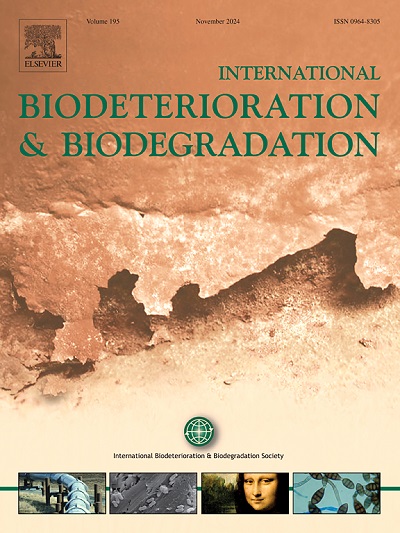真菌对市售传统化学产品的敏感性,以及对文化遗产保护中潜在替代产品的敏感性
IF 4.1
2区 环境科学与生态学
Q2 BIOTECHNOLOGY & APPLIED MICROBIOLOGY
International Biodeterioration & Biodegradation
Pub Date : 2025-06-09
DOI:10.1016/j.ibiod.2025.106137
引用次数: 0
摘要
传统的化学杀菌剂产品在文化遗产保护领域仍被广泛用于控制真菌的发展,尽管与环境和人类健康问题有关的批评越来越多。此外,生物杀灭产品的功效取决于所针对的微生物类型。因此,在使用杀菌剂之前评估真菌物种对它们的敏感性是至关重要的。本研究测试了193种不同真菌对8种市售杀菌剂的敏感性。其中5种产品是针对所有微生物沉积物的经典杀菌剂,它们由季铵盐或季铵盐与异噻唑啉酮的组合组成。其中一种杀菌剂由硝酸唑和特异性真菌组成。剩下的两种杀菌剂是专为绿色沉积物设计的更环保的产品,并被评估为传统杀菌剂的潜在替代品。它们分别由柠檬草精油和天竺葵酸组成。某些真菌属对杀菌剂的敏感性是属依赖的,而其他真菌属对杀菌剂的敏感性是种依赖的。经典杀菌剂生物素T™总体上抑制真菌生长最有效。只有较弱的真菌生长抑制与测试的两种产品作为替代溶液。真菌特异性产品在某些情况下非常有效,但在其他情况下效率低下,因此强调了在使用前测试产品的重要性。这些结果表明,无论传统杀菌剂产品有多么理想的替代方案,实际上很少有商业上可用的替代方案。本文章由计算机程序翻译,如有差异,请以英文原文为准。
Susceptibility of fungi to commercially available traditional chemical products and to potentially alternative products for use in cultural heritage preservation
Traditional chemical biocide products are still widely used to control fungal development in the field of cultural heritage preservation, despite increasing criticism related to environmental and human health concerns. Moreover, the efficacy of biocidal products varies depending on the type of micro-organism targeted. It is therefore crucial to assess the susceptibility of fungal species to biocide compounds prior to their use. This study tests the susceptibility of 193 different fungal species to eight commercially available biocide products. Five of these products were classical biocides that target all microorganism deposits, and were composed of either quaternary ammonium salts or a combination of quaternary ammonium salts and isothiazolinone. One biocide was composed of econazole nitrate and specifically targeted fungi. The two remaining biocides were greener products designed solely for green deposits, and were assessed as potential alternatives to classical biocides. They were composed of lemongrass essential oil and pelargonic acid, respectively. The susceptibility to biocides was genus dependent for several fungal genera, while it was species dependent in other cases. The classical biocide product Biotin T™ was the most efficient in inhibiting fungal growth overall. Only weak fungal growth inhibition was obtained with the two products that were tested as alternative solutions. The fungi-specific product was very efficient in some cases but inefficient in others, thus underlining the importance of testing the products before use. These results showed that however desirable alternative solutions to traditional biocide products may be, there are actually very few commercially available alternative solutions.
求助全文
通过发布文献求助,成功后即可免费获取论文全文。
去求助
来源期刊
CiteScore
9.60
自引率
10.40%
发文量
107
审稿时长
21 days
期刊介绍:
International Biodeterioration and Biodegradation publishes original research papers and reviews on the biological causes of deterioration or degradation.

 求助内容:
求助内容: 应助结果提醒方式:
应助结果提醒方式:


